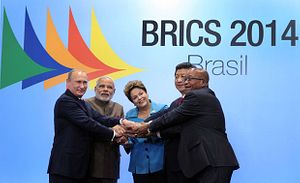If ever there were two major countries looking for new energy and focus in their relationship, then India and China are it. It was promising to see new Indian Premier Narendra Modi alongside President Xi Jinping and the other BRICS leaders in Brazil on July 15, declaring the establishment of a development fund to be located in Shanghai. More hopeful still was the announcement that Xi has accepted an invitation to go on a state visit to India later this year. A rebooted relationship with India would be a diplomatic coup for China. Does Modi’s arrival herald the moment for this?
In terms of trade alone, the current relationship between the world’s two largest nations is underwhelming. In 2012, combined merchandise trade between the two came to $80 billion, less than Australia’s current exports to China alone. The real problem, though, is that India runs a huge trade deficit, sending only $20 billion of goods to China, most of it in resources and raw materials. China sends back machinery. The two invest in each other, but at nowhere near the sort of levels seen between China and other countries in the region. If India were able to forge a landmark deal like the recent natural gas agreement between Russia and China, it would be a major step forward, but there is no obvious target for a signature deal. The two countries don’t even have a free trade agreement.
With a little political will, this might change quickly. China has lots of capital, and India needs to build a huge amount of infrastructure. But, as ever, something that seems simple on the surface is made considerably murkier due to politics. Of the many contested land borders the People’s Republic of China had when established in 1949, many of the remaining ones are with India. There has been glacial progress on these in the last few years, with many suspecting this will remain the case as long as the Tibetan government in exile is domiciled in India. If his record so far on the maritime disputes is any indication, Xi Jinping doesn’t look like he wants to be seen as conciliatory on territorial issues. And Modi, brought to power on a populist wave, is also likely to look tough on this issue.
Despite these negatives, the Xi visit to India later this year could offer some surprises. Xi does not want to see India fall into the laps of the U.S. as it seemed to do briefly in 2006 when former President George W. Bush visited New Delhi. At the time, writers like Bill Emmett speculated that there was a new triangulation going on, with America nurturing close ties with India to hedge against China. That moment passed, flushed away by the global economic crisis, the arrival of Obama, and a myriad of other issues. But for Xi, seeking more strategic space is a worthy objective, and having a stronger relationship with a country bordering much of China’s vast western landside is logical. It is likely that the route to this will, as is usually the case with China, be through trade. For this reason, Modi might find that he can drive a good deal on getting more access to China’s market for his country’s resources and goods when Xi visits.
The solution to the challenge of better relations, however, requires more than just increasing trade. India and China need a new framework for viewing their relationship. They often act like they don’t really understand the relevance they have for each other beyond narrow border issues, nor do they speak a common geopolitical language. For two countries that pride themselves on being ancient civilizations, and have long exercised a strong influence on each other (look at the spread, via the Tibetan plateau, of Buddhism in the Tang Dynasty), these days China and India look like fumbling, nervous youngsters meeting on a first date.
Modi and Xi have to do better, and it shouldn’t be hard. The interesting question for the rest of the world is how to respond to this new rapprochement—and whether to expect it to soon unravel.
































